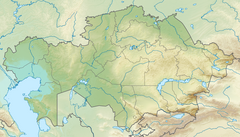| Saryozen Сарыөзен | |
|---|---|
 Final stretch of the Saryozen river Final stretch of the Saryozen river | |
 | |
| Physical characteristics | |
| Source | Kazakh Uplands |
| • location | Myrzhyk |
| Mouth | Akmolaisor (Shalkarsor) |
| • coordinates | 50°13′18″N 77°44′03″E / 50.22167°N 77.73417°E / 50.22167; 77.73417 |
| • elevation | 517 metres (1,696 ft) |
| Length | 115 km (71 mi) |
| Basin size | 6,056 km (2,338 sq mi) |
The Saryozen (Kazakh: Сарыөзен), also spelled Sary-Uzen (Kazakh: Сары-Өзен; Russian: Сары-Узень), is a river in the Karkaraly District of Karaganda Region and the Zhanasemey District of Abai Region, Kazakhstan. The river is 115 km (71 mi) long and the area of its basin is 6,056 km (2,338 sq mi).
The water is fresh and is used by locals to irrigate crops and watering livestock. The area surrounding the Saryozen is a seasonal grazing ground for local cattle.
History
The Saryozen valley is located in the Semipalatinsk Test Site complex. A total of 24 underground nuclear explosion tests were performed in wells between 1965 and 1980. The area is contaminated.
 |
Geography
The Saryozen belongs to the Irtysh basin. It has its sources in parallel rivulets flowing from the southern slopes of the Myrzhyk range and a north-flowing watercourse of Akshok mountain, at the eastern sector of the Kazakh Uplands. The river heads initially eastwards, then it bends northeastwards and in its lower course it bends slightly again and heads roughly northwards. Finally it ends in the Akmolaisor (Shalkarsor), an endorheic salt lake.
The Saryozen flows across a hilly and rugged region of the highland Kazakh steppe. There are many small endorheic lakes along the river course. The river fills in the spring with melted snow and rain, reaching its highest level at the end of April. By the summer it breaks up into disconnected pools.
See also
References
- Google Earth
- ^ Nature of Kazakhstan: Encyclopedia / General editor. B. O. Jacob. - Almaty: "Kazakh Encyclopedia" LLP, 2011. T.Z. - 304 pages. ISBN 9965-893-64-0 (T.Z.), ISBN 9965-893-19-5
- Semipalatinsk test site. Present state.
- International Nuclear Information System (INIS)
- "M-43 Topographic Chart (in Russian)". Retrieved 25 April 2024.
External links
This article related to a river in Kazakhstan is a stub. You can help Misplaced Pages by expanding it. |